Smart Solar Power Market Research, 2031
The global smart solar power market size was valued at $13.4 billion in 2021, and smart solar power industry is projected to reach $47.7 billion by 2031, growing at a CAGR of 13.6% from 2022 to 2031.
Smart solar power systems are the automated and internet connected version of solar energy system. The deployment of these devices is expected to help users minimize their electricity expenses and increase solar panels efficiency through real time monitoring and communication. The rising investment in the smart energy market and the reduction of solar PV costs are some factors driving the market growth.
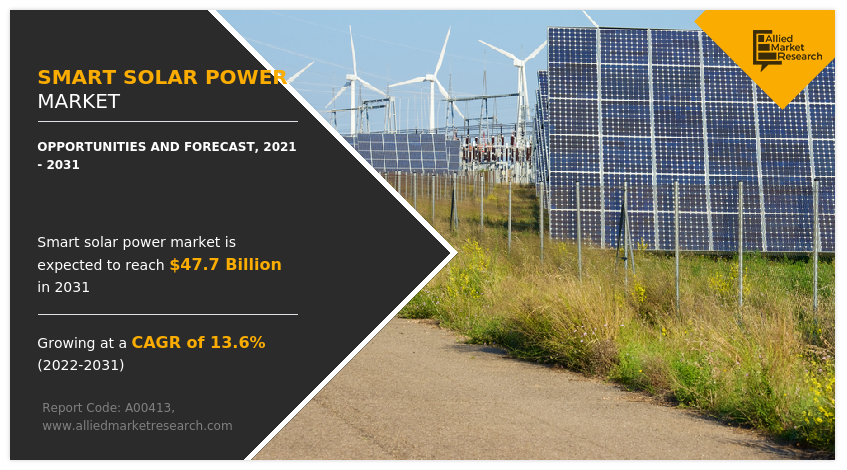
The presence of environmental protection regulations worldwide is enabling power generation companies to shift toward cleaner and to eco-friendly energy resources. Powerful countries across the globe are investing in renewable energy power generation to reduce their dependence on conventional power generation through fossil fuels. The innovation and rapid development in the internet technology and communication technology has led to the augmentation of solar power systems to make them smart through AI and cloud intelligence. This system offers improve functionality, operational efficiencies, optimized performance, and low maintainability. It enables real time monitoring, analytics, and communication function, which allows the manufacturer to deliver improved operational performance and control.
Intelligent grid also known as smart grid is a concept for transforming the electric power grid by using advanced automatic control and communications techniques and other forms of information technology. It integrates innovative tools and technologies from generation, transmission and distribution all the way to consumer appliances and equipment. The presence of aging power transmission infrastructure in the developed countries and increase in demand for intelligrid solutions in the developing country to construct smart cities will drive the demand for intelligrid solutions in smart solar power market. The above-mentioned factors are expected to provide numerous opportunities for the development of the market during the forecast period.
Remote metering (or Automatic Meter Reading) is the automatic collection of consumption, diagnostic and status data from a meter. This information is then transferred to a central location for billing, trouble-shooting and further analysis. The remote metering is primarily driven by government mandates and incentives for smart meter installation. According to the U.S. International Trade Commission, utilities are reluctant to invest in smart meter technology without a government mandate or incentives. The above-mentioned factors are a major reason to the gradual growth of the remote metering solutions in smart solar power market as compared to other solutions.
The global smart solar power market forecast is segmented on the basis of device, solution, application, and region.
On the basis of device, it is segmented into smart solar meters, intelligrid, and RFID. On the basis of solution, the market is segmented into asset management, network monitoring, meter data management, analytics, SCADA, remote monitoring, and outage management. On the basis of application, the market is segmented into commercial, industrial, and residential. Furthermore, the industrial segment is classified into government, healthcare, construction, and others.
Region wise, the market is studied across North America, Europe, Asia-Pacific, and LAMEA. Presently, North America accounts for the largest smart solar power market share, followed by Europe and Asia-Pacific.
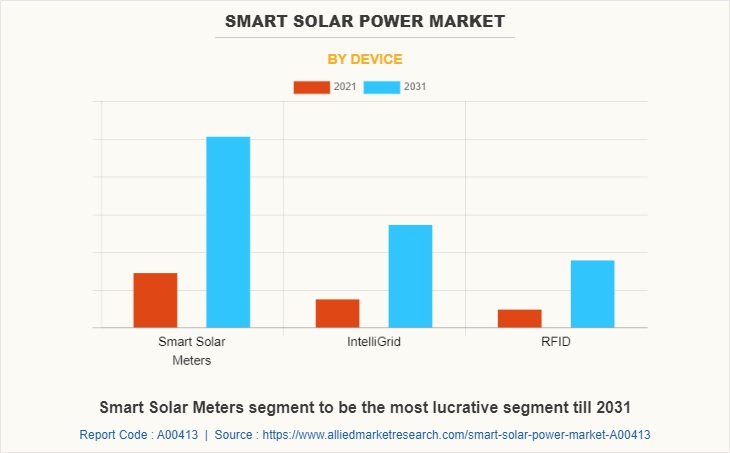
The smart solar meter segment dominates the global smart solar power market. Solar meters include a monitoring function that alerts plant owners about performance issues with PV plants, allowing them to quickly address issues and optimize return on investment. The projection of real-time PV power generation data from a PV system is measured using solar power meters. Solar power meters have gained widespread acceptance in residential, industrial, and commercial sectors, which acts as a key driver for the global smart solar power market. Furthermore, various benefits associated with solar power meters such as long-term stability, economical cost, wide spectral range, and automated transmission measurement foster the global market growth. The presence of above-mentioned factors will provide ample smart solar power opportunities for the development of the market.
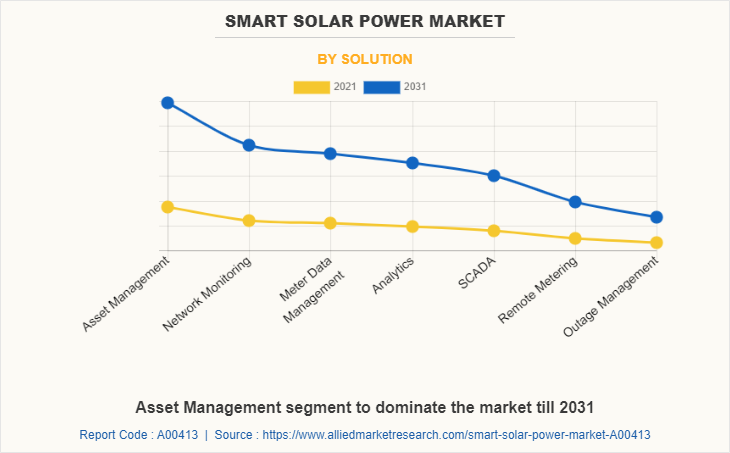
The asset management segment dominates the global smart solar power market. Solar asset management tracks and manages a physical asset, such as a solar plant, farm or site through the operational stages of its lifecycle. Solar asset management ensures the seamless collection of all data, documents and life events of the asset. The surge in the investment among the major manufacturing companies and power generation companies to invest toward the development of clean and renewable energy has led to the demand for asset management solutions in the solar industry. The presence of investment in large scale solar power plants across the globe has propelled the demand for this market. The above-mentioned factors will provide ample opportunities for the development of the market.
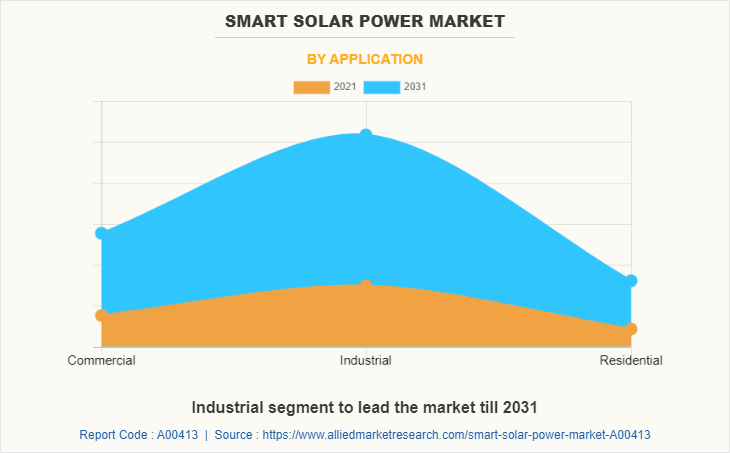
The industrial segment dominates the global smart solar power market. The rapid industrialization and decrease in fossil fuel resources across the globe have led to increase in the demand for the industrial utilization of solar panels. Increase in utilization of portable electronic gadgets and are connected with internet of things have led to increase in the need for the communication industry. The presence of demand and need for backup energy services have led to the demand for the solar panels in the communication industry. The presence of low pure water resources in the Middle East countries in LAMEA region has led to the increasing investment in the desalination plants. The increasing construction of desalination plants has positive impact on the demand for solar power generation. The presence of this demand is expected to provide ample opportunities for the development of the market.
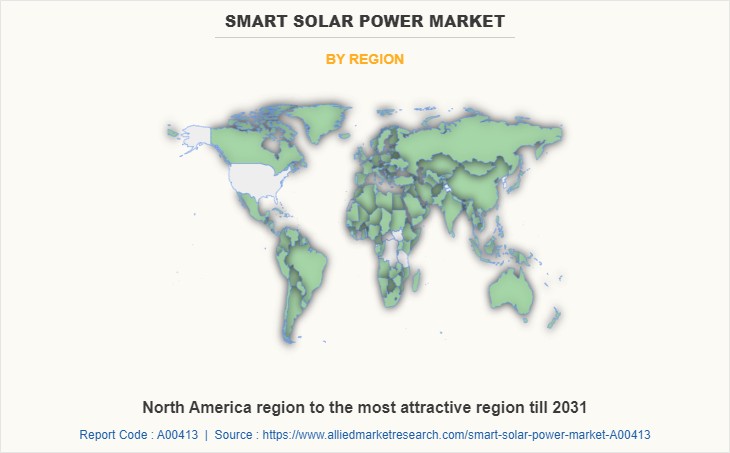
North America region dominates the global smart solar power market. In 2021, the solar industry generated more than $33 billion of private investment in the American economy. According to Electric Power Annual, solar power accounted for 3% of U.S. electricity generation from all sources in 2020. In EIA Short-Term Energy Outlook, forecast that solar will account for 5% of U.S. electricity generation in 2022. In total U.S. power generation, solar energy accounts for 2% as of 2019 and 3% in 2020 to serve 16.4 million and 18 million average American homes respectively. According to the United States National Renewable Energy Laboratory (NREL), since 2010, there has been a 64%, 69%, and 82% reduction in the cost of residential, commercial-rooftop, and utility-scale PV systems in the U.S., respectively. Over the past decade, the efficiency of solar PV panels has risen steadily. As of January 2022, SunPower’s monocrystalline solar PV panels had the highest efficiency rating of any commercially available solar panel brand in the market. In April 2020, NREL announced that its six-junction solar cell achieved a record 47.1% solar conversion efficiency, the highest globally. The above-mentioned factors and innovations will provide ample opportunities for the smart solar power market growth.
The major companies profiled in this report include Aclara Software, GE Energy, ABB, CAlico Energy Services, HCL Technologies, Siemens, Echelon Corporation, Schneider Electric, Urban Green Energy International, Landis+GYR AG, Sensus USA Inc., Silver Spring Networks INC., Itron Inc., HCL Technologies, and Huawei Technologies Co., Ltd. Rapid industrialization, urbanization and gradual increase in population have led to increase in demand for power. Additional growth strategies such as expansion of production capacities, acquisition, partnership and research & innovation in new technologies related to smart solar power have led to attain key developments in the global smart solar power market trends.
Impact of Covid-19 on Smart Solar Power Market
The global COVID-19 pandemic has negative impact on the smart solar power market. Owing to the outbreak of the COVID-19 pandemic, governments of various countries have implemented lockdown, which has led to shutdown of factories in scores of cities and provinces across the world, thus, leading to sharp slowdown in the output from residential to industrial sectors. Moreover, companies are dealing with missing sales and fractured supply chains as production activities shutdowns. Among other problems, it might be possible that companies may not be able to meet project delivery timelines that could alter tax treatment or eligibility for state incentives for such projects. For instance, recently in July 2020, the Seychelles government has confirmed that the construction of a floating solar PV power plant will be delayed due to the global pandemic. All over the globe, solar project developers were worried about project delays due to the slowdown of manufacturing in China.
Post pandemic outbreak, the gradual surge in the construction sector has led increase in the demand for solar power market. The governments of various developing and developed countries has invested in the development of solar power plants in order to reduce their imports of fossil fuels, and other energy resources. Furthermore, increase in awareness among the people regarding the impact of utilization of solar power to reduce growing electricity tariffs in residential sector is expected to drive the demand for smart solar power systems. The trend is expected to continue during the forecast period.
Key Benefits For Stakeholders
- This report provides a quantitative analysis of the market segments, current trends, estimations, and dynamics of the smart solar power market analysis from 2021 to 2031 to identify the prevailing smart solar power market opportunities.
- The market research is offered along with information related to key drivers, restraints, and opportunities.
- Porter's five forces analysis highlights the potency of buyers and suppliers to enable stakeholders make profit-oriented business decisions and strengthen their supplier-buyer network.
- In-depth analysis of the smart solar power market segmentation assists to determine the prevailing market opportunities.
- Major countries in each region are mapped according to their revenue contribution to the global market.
- Market player positioning facilitates benchmarking and provides a clear understanding of the present position of the market players.
- The report includes the analysis of the regional as well as global smart solar power market trends, key players, market segments, application areas, and market growth strategies.
Smart Solar Power Market Report Highlights
| Aspects | Details |
| Market Size By 2031 | USD 47.7 billion |
| Growth Rate | CAGR of 13.6% |
| Forecast period | 2021 - 2031 |
| Report Pages | 340 |
| By Device |
|
| By Solution |
|
| By Application |
|
| By Region |
|
| Key Market Players | GE Energy, HCL Technologies Ltd, Landis+GYR AG, Huawei Technologies Co., Ltd, Echelon Corporation, Sensus USA Inc., ABB Ltd, Siemens AG, Silver Spring Networks INC., Itron Inc., Aclara Software, Urban Green Energy International, CAlico Energy Services, Schneider Electric |
Analyst Review
According to CXO perspective, the global smart solar power market is expected to witness increased demand during the forecast period, due to increase in demand for clean energy resources. Increase in awareness among people regarding the utilization of solar energy is also driving the market growth.
Solar energy system that is run through a solar inverter and connected with a smart meter is known as smart solar power systems. Together they supply real-time data on the performance of your energy system. Increasing government initiatives to shift toward clean energy sources is another factor which is expected to boost the market. However, factors such as high initial cost and higher maintenance costs will hamper the development of the market. However, increase in government investments to innovate and develop various technologies to make the solar energy production more efficient is expected to have positive impact over the smart solar power market.
Increase in adoption of green energy and emergence of smart cities and increase in environmental awareness and technological innovation are the key factors boosting the Smart solar power market growth.
Increase in government initiatives to shift toward smart & sustainable energy sources is the Main Driver of Smart solar power Market.
Aclara Software, GE Energy, ABB, CAlico Energy Services, HCL Technologies, Siemens, Echelon Corporation, Schneider Electric, Urban Green Energy International, Landis+GYR AG, Sensus USA Inc., Silver Spring Networks INC., Itron Inc., HCL Technologies, and Huawei Technologies Co., Ltd.
Industrial based application is projected to increase the demand for Smart solar power Market
The global smart solar power market is segmented on the basis of device, solution, application, and region. On the basis of device, it is segmented into smart solar meters, intelligrid, and RFID. On the basis of solution, the market is segmented into asset management, network monitoring, meter data management, analytics, SCADA, remote monitoring, and outage management. On the basis of application, the market is segmented into commercial, industrial, and residential. Furthermore, industrial segment is bifurcated into government, healthcare, construction, and others. Region wise, the market is studied across North America, Europe, Asia-Pacific, and LAMEA.
The market value of Smart solar power in 2031 is expected to be $47.7 billion
Post pandemic outbreak, the gradual surge in the construction sector has led increase in the demand for solar power market. The governments of various developing and developed countries has invested in the development of solar power plants in order to reduce their imports of fossil fuels, and other energy resources. Furthermore, increase in awareness among the people regarding the impact of utilization of solar power to reduce growing electricity tariffs in residential sector is expected to drive the demand for smart solar power systems. The trend is expected to continue during the forecast period.
Loading Table Of Content...



